Table of Contents
- Introduction
- Editor’s Choice
- Functional and Natural Health Food in the Nutrition Industry Value
- Global Dietary Supplements in the Nutrition Industry Value
- Nutrition Industry Sales and Consumption Trends
- Regional Analysis
- Demographic Insights
- Consumer Behavior and Trends
- Satisfaction of Consumers Concerning the Health Benefits of Food Supplements
- Spending Habits and Cost
- Regulations for Nutritional Products
Introduction
The nutrition industry is a diverse field encompassing dietary supplements, functional foods, clinical nutrition, sports nutrition, and organic products.
It is shaped by trends such as a focus on health and wellness, digital health integration, sustainability, and the personalized nutrition industry. Major players include large food and beverage companies as well as specialized nutritional firms.
Challenges include regulatory compliance and market saturation, while opportunities arise from innovation, emerging markets, and technology integration. The industry is driven by consumer demand for healthier lifestyles and environmental sustainability.
Editor’s Choice
- Healthy Snack Market size was valued at USD 84.4 billion and is expected to grow to around USD 142.6 billion by 2032.
- The global functional and natural health food market revenue. It is expected to reach USD 24.75 billion in 2024.
- The global dietary supplements market is projected. To attain a value of USD 306 billion in 2033.
- Sports non-protein products increased from USD 1.8 billion in 2014 to USD 2.1 billion in 2016, reaching USD 2.4 billion in 2018 and further rising to USD 2.6 billion by 2020.
- In 2023, global animal protein consumption is estimated to vary significantly by source. Fish leads the consumption chart with an estimated 165 million metric tons.
- In 2019, Canadian respondents showed a strong interest in healthy food trends and a strong inclination towards plant-based and innovative food options. Plant-based meat substitutes garnered the highest interest, with 75% of respondents expressing interest.
- In 2017, the most popular types of vitamin and mineral supplements among U.S. adults were led by multivitamins. With 73% of adult supplement users incorporating them into their routine.
- In 2019, French consumers had varied opinions on the health benefits of nutritional supplements. A significant majority, 61%, reported being rather satisfied. With the health benefits provided by these products.
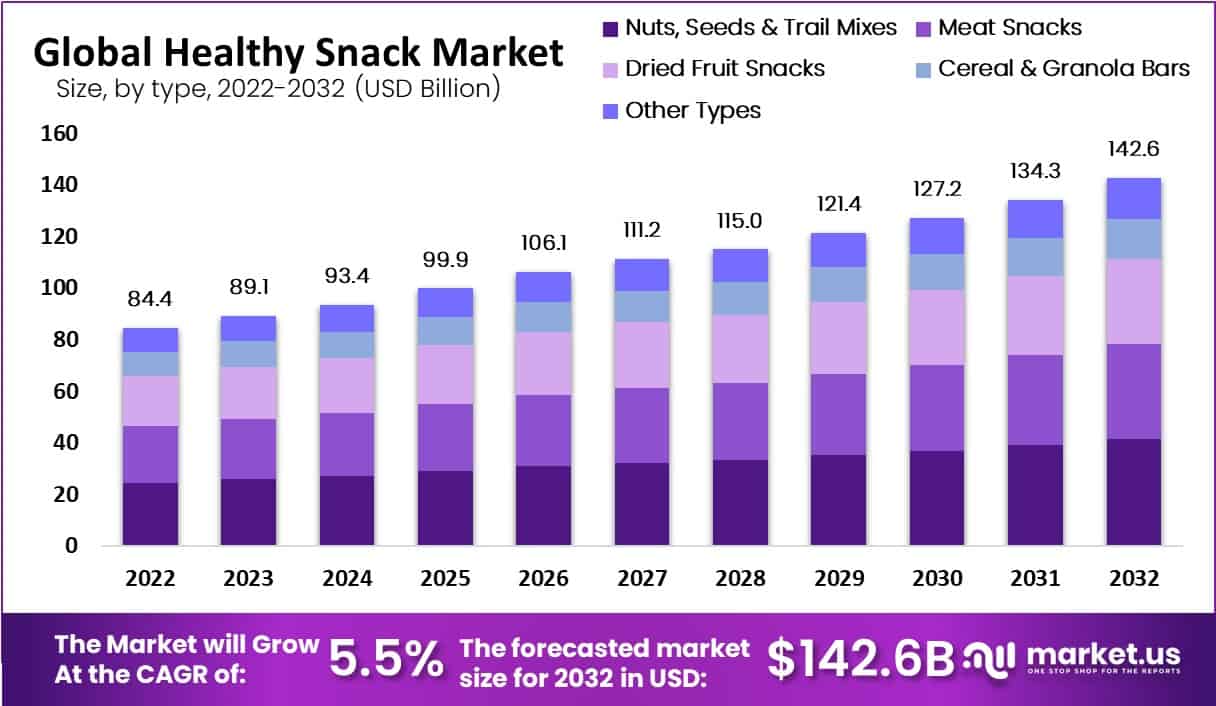
Functional and Natural Health Food in the Nutrition Industry Value
- The global functional and natural health food market has been experiencing consistent growth. With its value reaching USD 23.50 billion in 2023.
- Projections indicate a steady increase over the following years. The market is expected to grow to USD 24.75 billion in 2024 and USD 26.06 billion in 2025.
- The growth trajectory is expected to persist. With the market reaching USD 35.52 billion in 2031. USD 37.40 billion in 2032, and culminating at USD 38.50 billion by 2033.
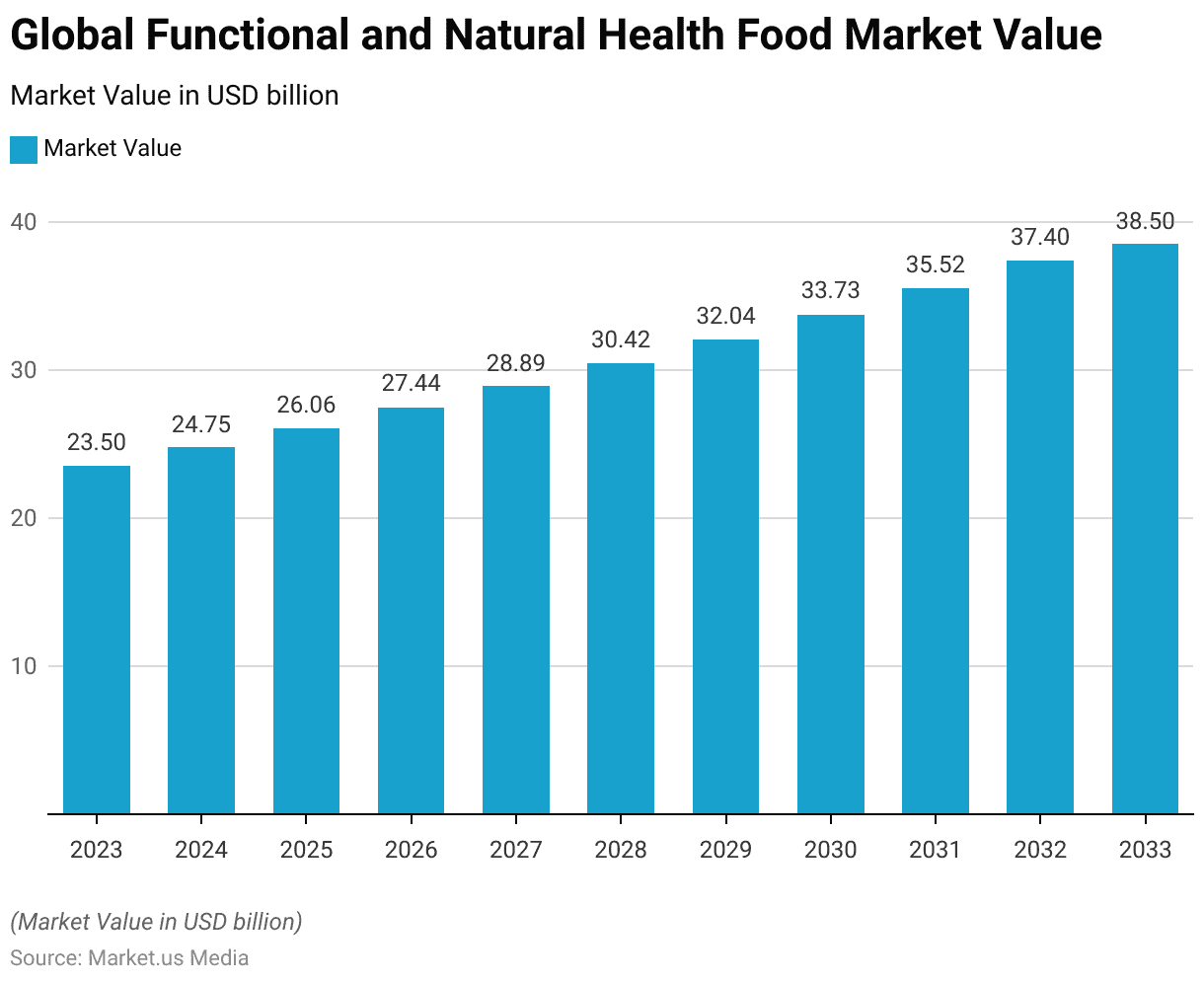
Global Dietary Supplements in the Nutrition Industry Value
- The global dietary supplements market is projected to witness substantial growth. Over the coming decade at a CAGR of 7.0%.
- In 2023, the market value is estimated at USD 156 billion.
- By 2033, the global dietary supplements market. It is expected to attain a value of USD 306 billion.
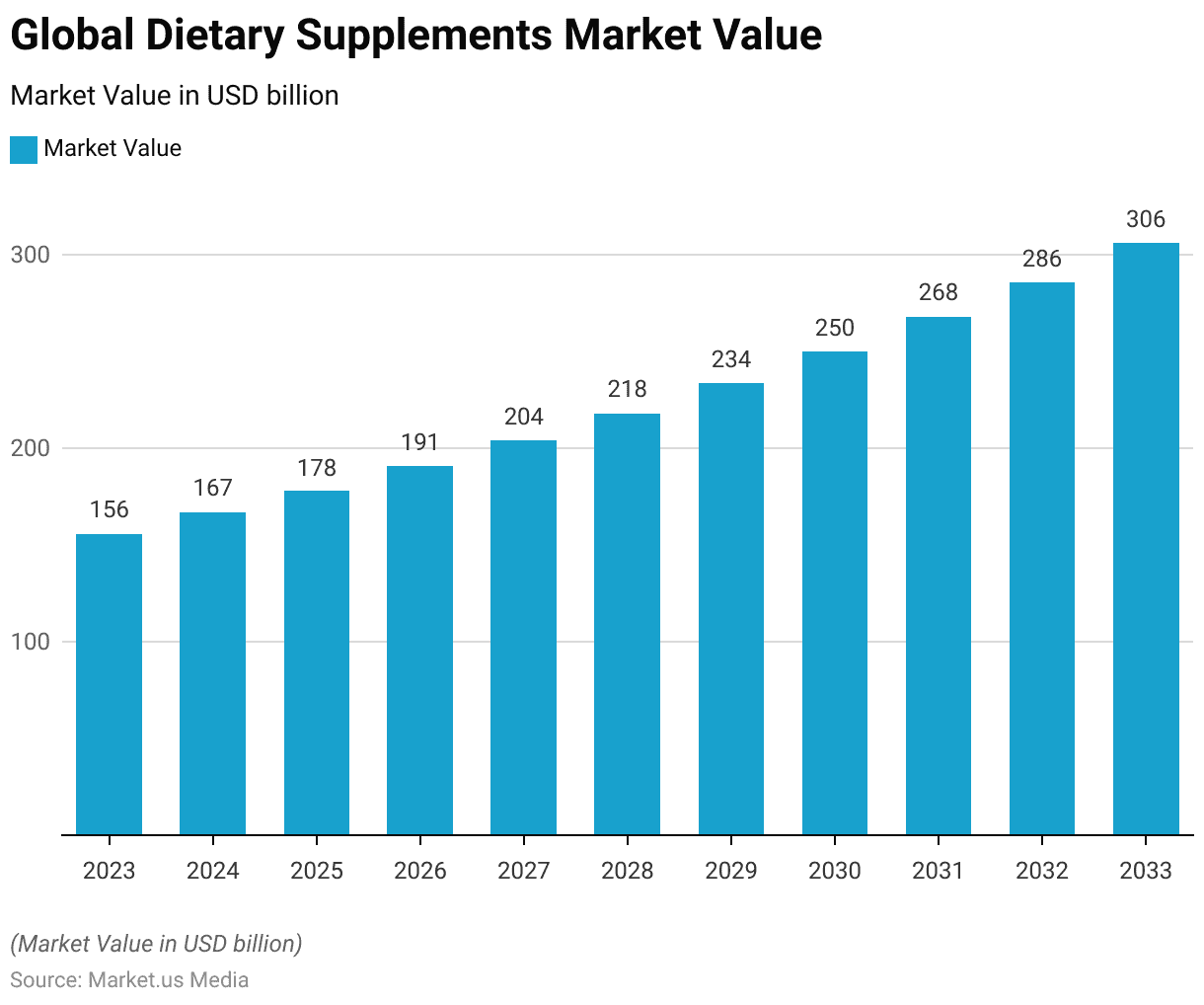
Nutrition Industry Sales and Consumption Trends
Global Consumer Sports Nutrition Industry Sales
- Global consumer sports nutrition industry sales have shown significant growth across various product types from 2014 to 2020.
- Sports non-protein products increased from USD 1.8 billion in 2014 to USD 2.1 billion in 2016. Reaching USD 2.4 billion in 2018 and further rising to USD 2.6 billion by 2020.
- Sales of sports protein ready-to-drink (RTD) products grew from USD 1 billion in 2014 to USD 1.1 billion in 2016, then to USD 1.4 billion in 2018, and USD 1.5 billion in 2020.
- The market for sports protein powder saw substantial growth. Escalating from USD 6.2 billion in 2014 to USD 7.7 billion in 2016, reaching USD 9.3 billion in 2018 and USD 10.9 billion by 2020.
- Similarly, sales of sports protein bars increased from USD 0.8 billion in 2014 to USD 1 billion in 2016. Then to USD 1.1 billion in 2018 and USD 1.2 billion by 2020.

Global Animal Protein Consumption
- In 2023, global animal protein consumption is estimated to vary significantly by source. Fish leads the consumption chart with an estimated 165 million metric tons.
- Poultry follows with a substantial consumption of 140 million metric tons.
- Pork is also a major source of animal protein, with an estimated consumption of 122 million metric tons.
- Beef consumption is projected at 72 million metric tons. Indicating its significant role in global diets.
- Atlantic salmon, while lower in comparison, still contributes to the animal protein market with an estimated consumption of 2 million metric tons.
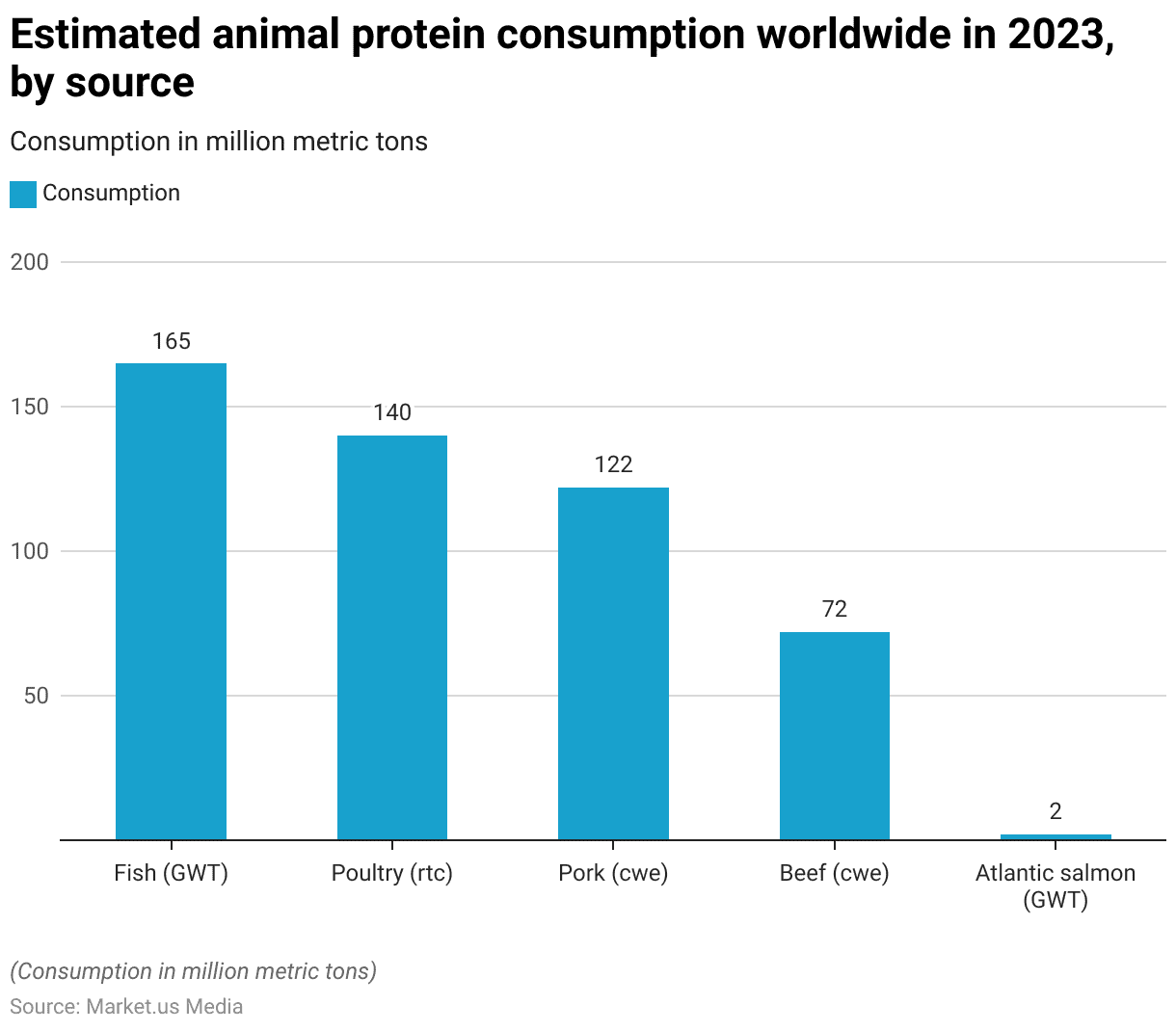
Regional Analysis
Europe
Value of the Dietary Supplements Market in Europe – By Country
- The dietary supplements market in Europe demonstrated notable growth across various countries between 2015 and 2020. In Italy, the market value increased from 1,424.2 million euros in 2015 to 1,601.5 million euros in 2020.
- Russia saw a significant rise from 887.7 million euros to 1,079.9 million euros over the same period. Germany’s market remained relatively stable, with a slight increase from 966.6 million euros to 967.2 million euros.
- The United Kingdom experienced growth from 737 million euros to 755.2 million euros. While France saw an increase from 683.8 million euros to 724.8 million euros. In Poland, the market value rose from 353.4 million euros to 407.5 million euros, and Norway saw a slight decrease from 231.5 million euros to 220.4 million euros.
- Finland’s market value increased from 201.2 million euros to 207.4 million euros, and Sweden experienced growth from 181.5 million euros to 199.3 million euros.
- Belgium’s market remained stable, increasing marginally from 193.6 million euros to 194 million euros, while Spain saw growth from 182.6 million euros to 193.5 million euros.

North America
United States
Dietary Supplement Usage in U.S. Adults – By Region
- In 2019, the usage of dietary supplements among U.S. adults varied by region. In the Northeast, 73% of adults reported using dietary supplements.
- The South had the highest usage rate, with 80% of adults taking supplements.
- In the Midwest, the percentage was slightly lower at 74%, while the West reported a 78% usage rate.
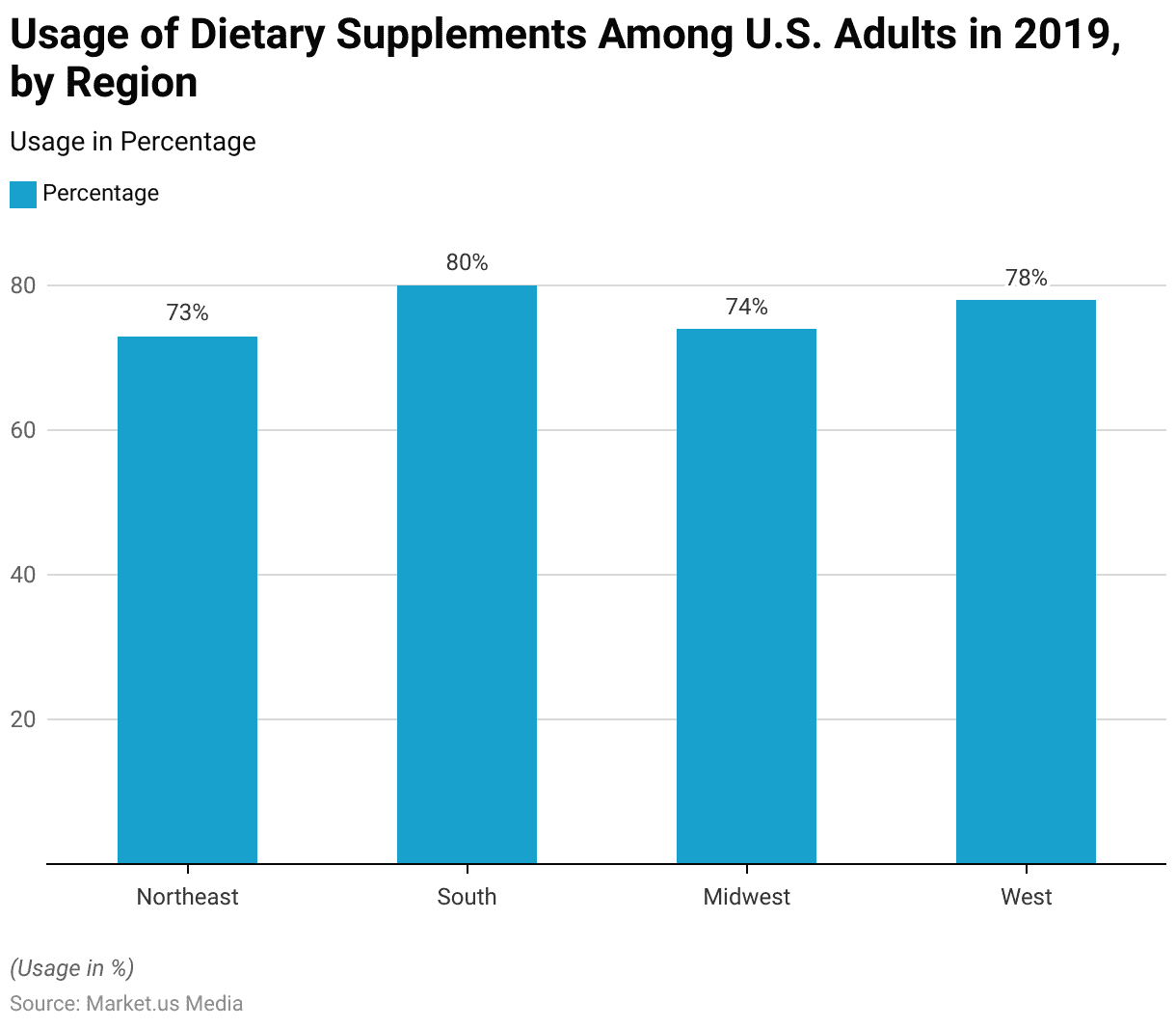
Asia-Pacific
India
Value of Ayurvedic and Herbal Products Exported from India
- The export value of Ayurvedic and herbal products from India has demonstrated a notable upward trend from the financial year 2015 to 2024.
- In FY 2015, the export value was USD 354.68 million, which increased to USD 364 million in FY 2016.
- This positive trend continued, with the export value reaching USD 625.48 million in FY 2023 and an estimated USD 651.17 million in FY 2024.
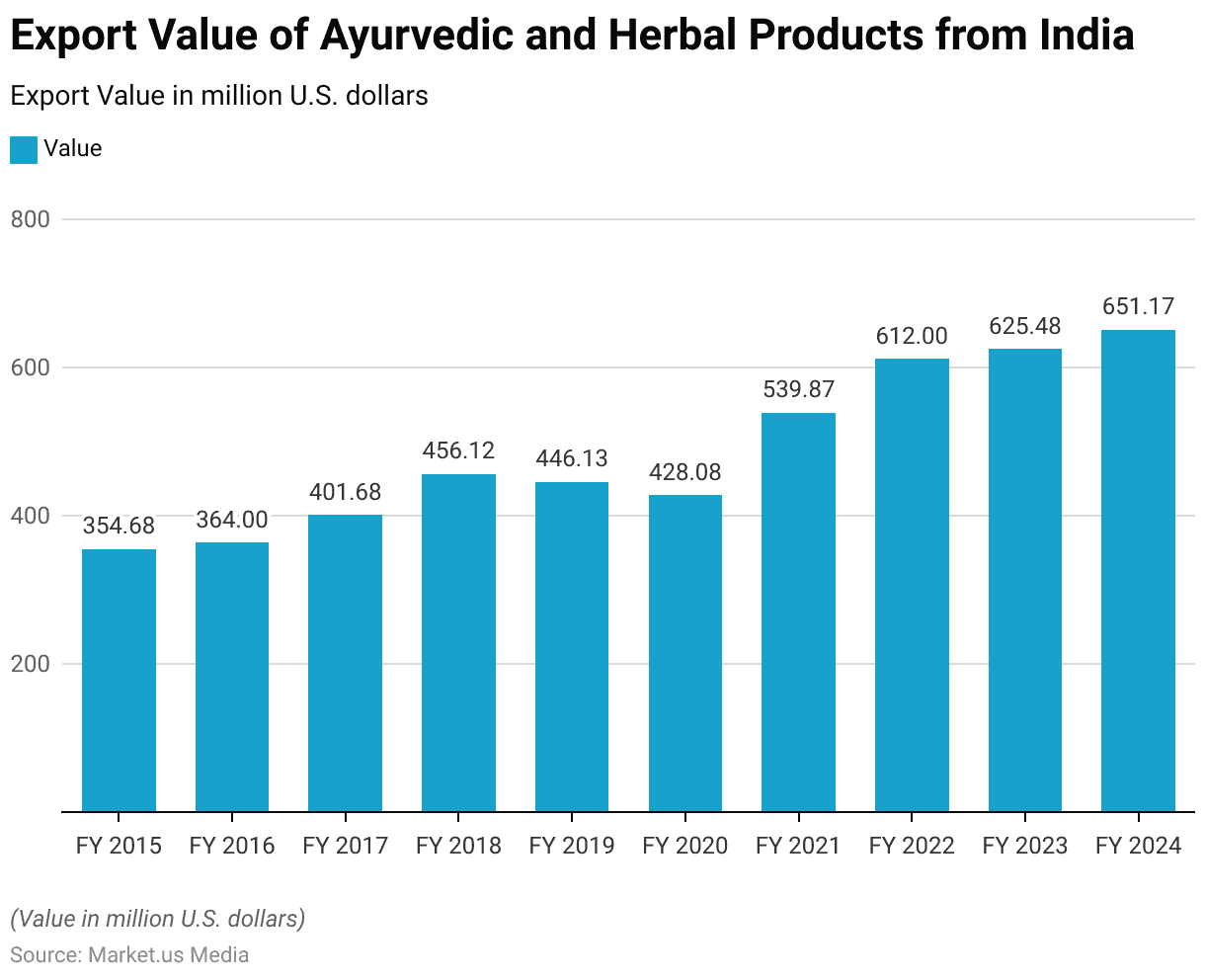
Demographic Insights
By Age
- In 2015, the consumption of vitamin and mineral supplements among adults in Scotland varied across different age groups.
- The share of respondents aged 16-24 who reported using these supplements was 21%.
- This percentage increased to 29% among those aged 25-34.
- For the 35-44 age group, 25% of respondents consumed vitamin and mineral supplements. While 24% of those aged 45-54 did so.
- Among individuals aged 55-64, the share was 26%.
- The highest consumption rates were observed in the older age groups. With 33% of those aged 65-74 and 34% of respondents aged 75 and above reporting supplement use.
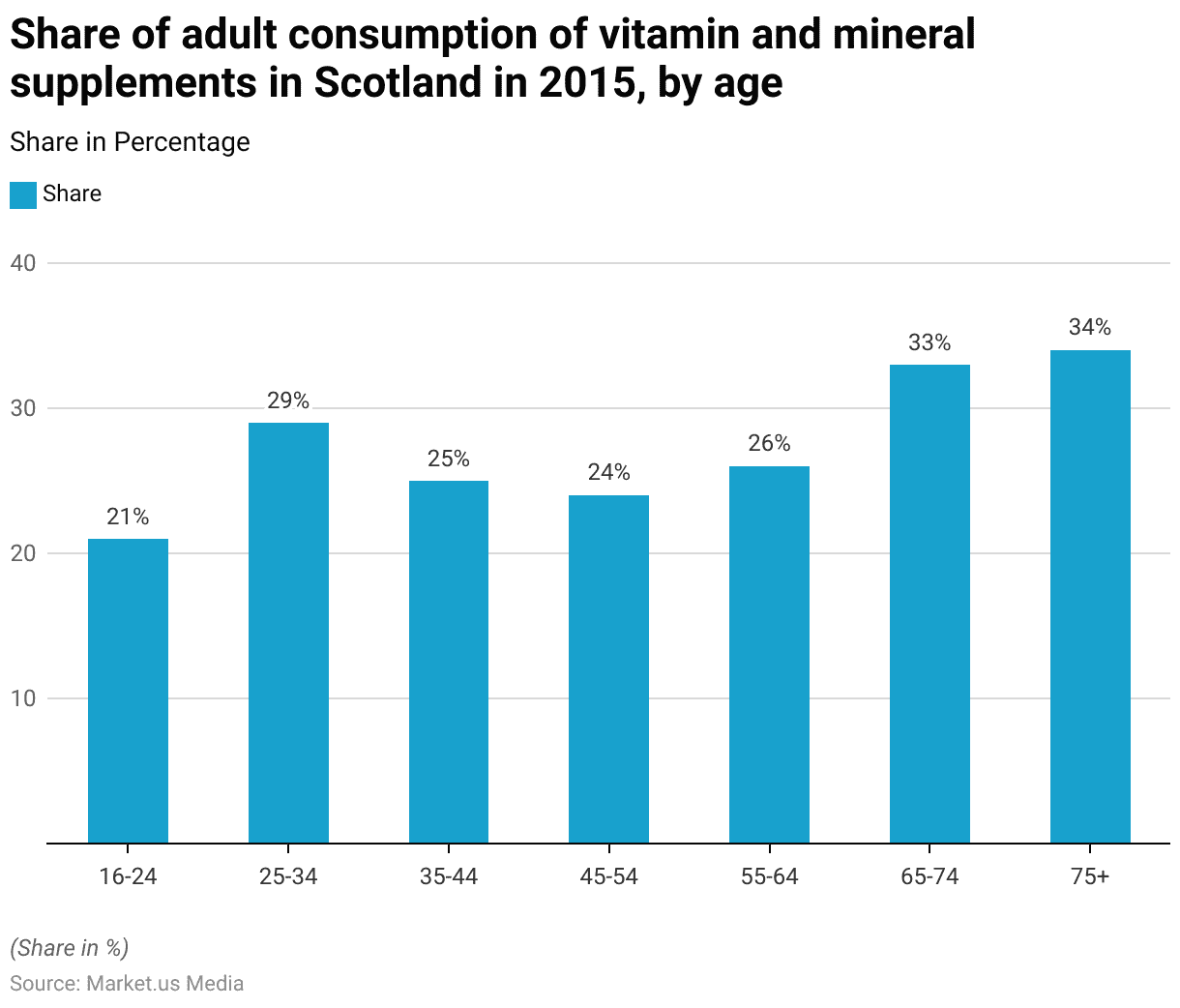
By Gender
- As of 2018, the usage of different types of dietary supplements among U.S. adults showed distinct patterns based on gender.
- Multivitamins were the most commonly used supplement. With 72% of women and 78% of men reporting their use.
- Vitamin D was taken by 40% of women and 35% of men.
- Calcium supplements were used by 32% of women. While no corresponding data was provided for men.
- Vitamin C consumption was higher among men (33%) compared to women (28%).
- Similarly, 28% of women and 24% of men reported using Vitamin B or B Complex supplements.
- Magnesium was taken by 22% of women, with no data for men. Protein supplements are used by 21% of both women and men.
- Probiotics were used by 21% of women. While 21% of men reported taking Omega-3 or fatty acid supplements, with no corresponding data for women.
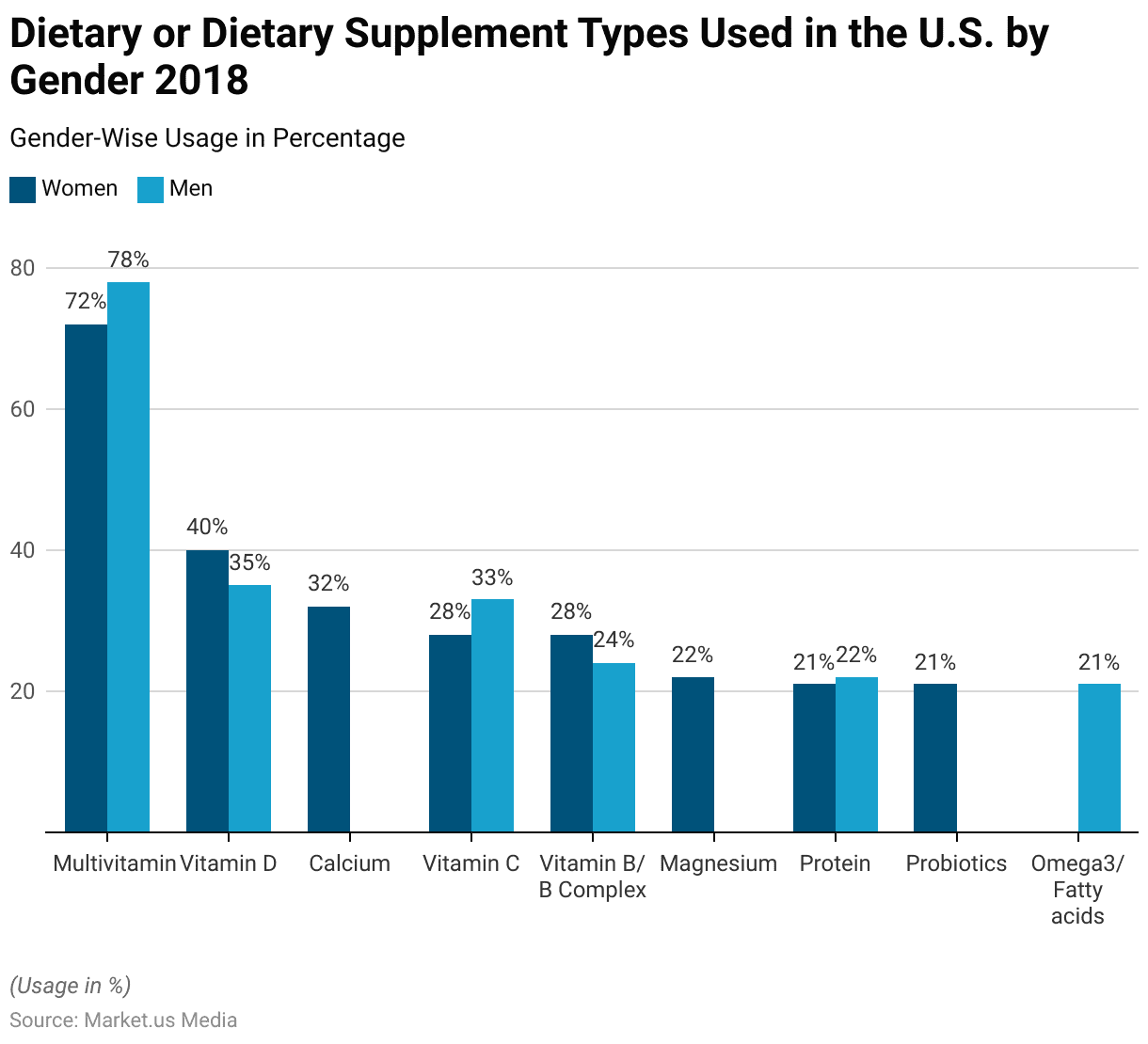
Consumer Behavior and Trends
Interest in Healthy Food Trends
- In 2019, Canadian respondents showed a strong interest in healthy food trends and a strong inclination towards plant-based and innovative food options.
- Plant-based meat substitutes garnered the highest interest, with 75% of respondents expressing interest.
- This was closely followed by turmeric-spiced food and beverages. Which attracted 72% of respondents.
- Plant-based dairy substitutes were of interest to 69%, while 68% showed a preference for cauliflower pizza crust.
- Sea-based protein and organic wine each captured the interest of 66% of respondents.
- Oat milk and fermented products were each favored by 58% of respondents.
- Non-alcoholic beer, wine, and spirits appealed to 56% of respondents. While 48% were interested in CBD-infused foods and beverages.
- The least interest was observed in insect protein and eating insects. With 38% of respondents indicating interest.

Satisfaction of Consumers Concerning the Health Benefits of Food Supplements
- In 2019, French consumers had varied opinions on the health benefits of nutritional supplements.
- A significant majority, 61%, reported being rather satisfied. With the health benefits provided by these products.
- Meanwhile, 17% of respondents were totally satisfied.
- An equal percentage, 17%, were rather unsatisfied with the benefits of nutritional supplements.
- A small proportion, 3%, were unsatisfied, and 2% of respondents did not provide an answer.
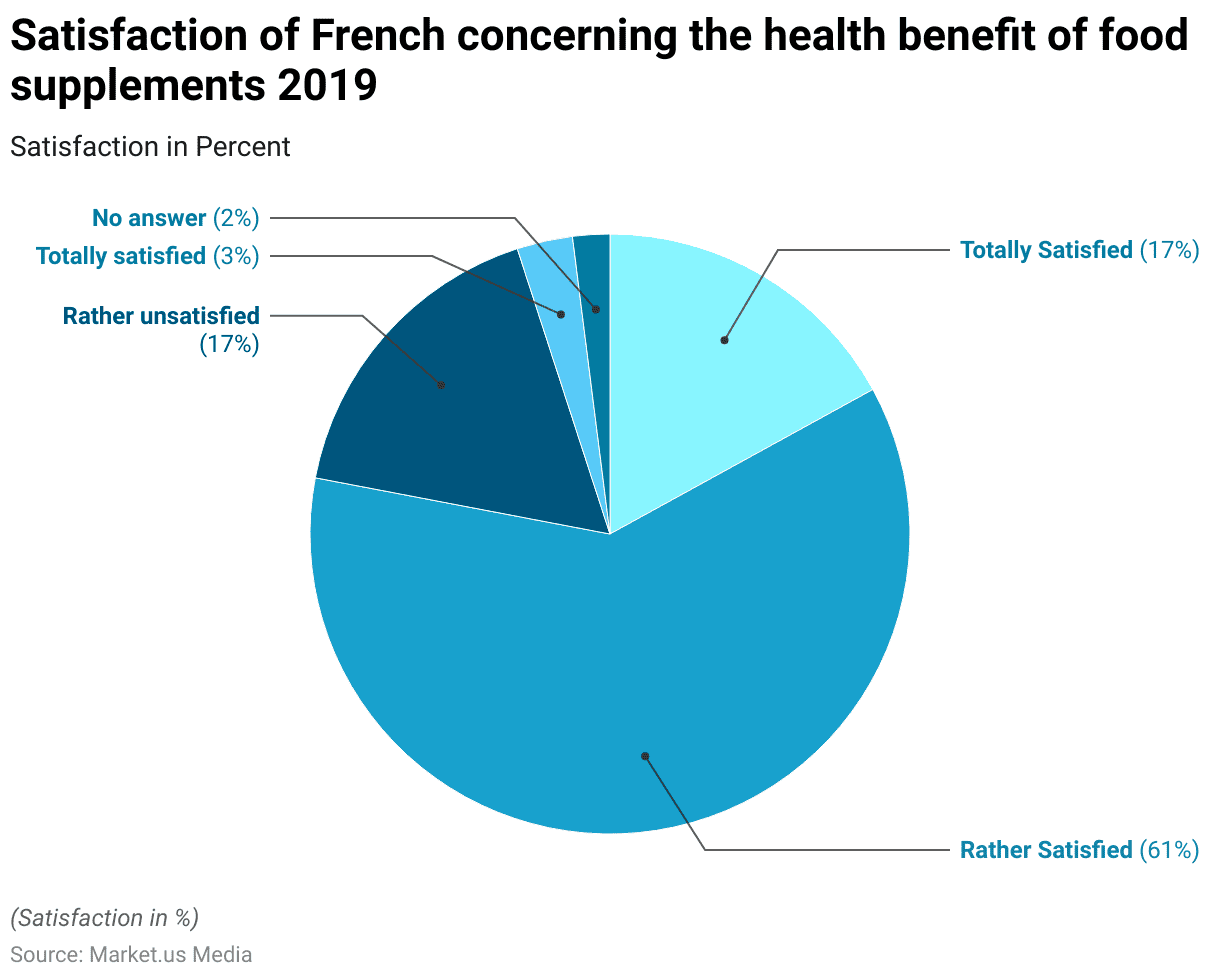
Spending Habits and Cost
- Despite inflation and economic uncertainty, 65% of supplement users have maintained their monthly spending on supplements at the same level as the previous year. 29% have increased their spending, while 6% have decreased it.
- Men are more likely than women to report spending more, individuals aged 18-34 are more inclined than those over 55, and regular supplement users are more prone to increased spending compared to seasonal or occasional users.
- A higher proportion of non-users now consider supplements too expensive. With 28% expressing this view this year, compared to 17% in 2021 and 19% in 2019.
Regulations for Nutritional Products
- Regulations for nutritional products vary significantly across countries, reflecting diverse public health priorities and market practices.
- In the United States, the FDA mandates comprehensive nutritional labeling on food packaging, detailing calories, fats, sugars, and other key nutrients. With recent updates focusing on front-of-package labeling to enhance consumer transparency.
- Canada has similar stringent requirements under Health Canada’s Healthy Eating Strategy, with a compliance deadline set for January 1, 2026. Ensuring products feature clear nutritional symbols and detailed nutrient content claims.
- Vietnam has implemented mandatory nutritional labeling, effective February 2024, requiring detailed disclosures of energy, protein, carbohydrates, fats, and sodium on all food products.
- The Philippines recently updated its policies to align with international standards, mandating labels to display sodium and caloric content based on the Recommended Energy and Nutrient Intakes (RENI).
Discuss your needs with our analyst
Please share your requirements with more details so our analyst can check if they can solve your problem(s)



